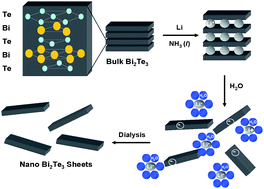Lithium intercalation and exfoliation of layered bismuth selenide and bismuth telluride†
Abstract
Alloys of

- This article is part of the themed collection: Layered materials: structure and properties
* Corresponding authors
a
MST-7, Los Alamos National Laboratory, MS E544, Los Alamos, New Mexico, USA
E-mail:
zding@lanl.gov
Fax: +1-505-6672185
Tel: +1-505-6062078
b
Department of Chemistry and Biochemistry and California NanoSystems Institute, University of California Los Angeles, 607 Charles E. Young Drive Box 951569, Los Angeles, California, USA
E-mail:
kaner@chem.ucla.edu
Fax: +1-310-206-4038
Tel: +1-310-825-5346
c
Department of Chemistry, National Dong Hwan University, No.1, Sec.2, Da Hsueh Rd., Shoufeng, Taiwan
E-mail:
schuang@mail.ndhu.edu.tw
Alloys of

 Please wait while we load your content...
Something went wrong. Try again?
Please wait while we load your content...
Something went wrong. Try again?
Z. Ding, S. K. Bux, D. J. King, F. L. Chang, T. Chen, S. Huang and R. B. Kaner, J. Mater. Chem., 2009, 19, 2588 DOI: 10.1039/B820226E
To request permission to reproduce material from this article, please go to the Copyright Clearance Center request page.
If you are an author contributing to an RSC publication, you do not need to request permission provided correct acknowledgement is given.
If you are the author of this article, you do not need to request permission to reproduce figures and diagrams provided correct acknowledgement is given. If you want to reproduce the whole article in a third-party publication (excluding your thesis/dissertation for which permission is not required) please go to the Copyright Clearance Center request page.
Read more about how to correctly acknowledge RSC content.
 Fetching data from CrossRef.
Fetching data from CrossRef.
This may take some time to load.
Loading related content
